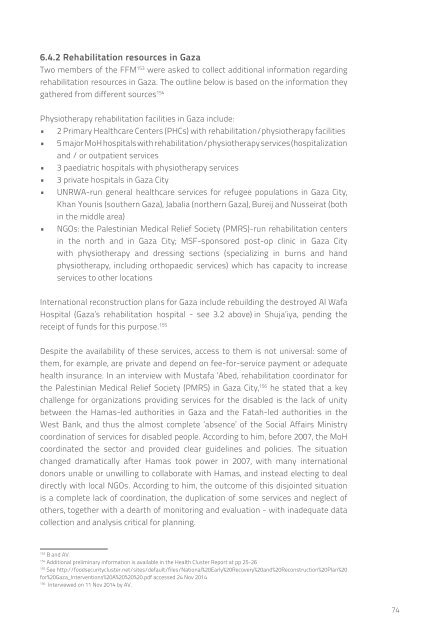HHo0s
HHo0s
HHo0s
Create successful ePaper yourself
Turn your PDF publications into a flip-book with our unique Google optimized e-Paper software.
6.4.2 Rehabilitation resources in GazaTwo members of the FFM 153 were asked to collect additional information regardingrehabilitation resources in Gaza. The outline below is based on the information theygathered from different sources 154Physiotherapy rehabilitation facilities in Gaza include:• 2 Primary Healthcare Centers (PHCs) with rehabilitation/physiotherapy facilities• 5 major MoH hospitals with rehabilitation/physiotherapy services (hospitalizationand / or outpatient services• 3 paediatric hospitals with physiotherapy services• 3 private hospitals in Gaza City• UNRWA-run general healthcare services for refugee populations in Gaza City,Khan Younis (southern Gaza), Jabalia (northern Gaza), Bureij and Nusseirat (bothin the middle area)• NGOs: the Palestinian Medical Relief Society (PMRS)-run rehabilitation centersin the north and in Gaza City; MSF-sponsored post-op clinic in Gaza Citywith physiotherapy and dressing sections (specializing in burns and handphysiotherapy, including orthopaedic services) which has capacity to increaseservices to other locationsInternational reconstruction plans for Gaza include rebuilding the destroyed Al WafaHospital (Gaza’s rehabilitation hospital - see 3.2 above) in Shuja’iya, pending thereceipt of funds for this purpose. 155Despite the availability of these services, access to them is not universal: some ofthem, for example, are private and depend on fee-for-service payment or adequatehealth insurance. In an interview with Mustafa ‘Abed, rehabilitation coordinator forthe Palestinian Medical Relief Society (PMRS) in Gaza City, 156 he stated that a keychallenge for organizations providing services for the disabled is the lack of unitybetween the Hamas-led authorities in Gaza and the Fatah-led authorities in theWest Bank, and thus the almost complete ‘absence’ of the Social Affairs Ministrycoordination of services for disabled people. According to him, before 2007, the MoHcoordinated the sector and provided clear guidelines and policies. The situationchanged dramatically after Hamas took power in 2007, with many internationaldonors unable or unwilling to collaborate with Hamas, and instead electing to dealdirectly with local NGOs. According to him, the outcome of this disjointed situationis a complete lack of coordination, the duplication of some services and neglect ofothers, together with a dearth of monitoring and evaluation - with inadequate datacollection and analysis critical for planning.153B and AV.154Additional preliminary information is available in the Health Cluster Report at pp 25-26155See http://foodsecuritycluster.net/sites/default/files/National%20Early%20Recovery%20and%20Reconstruction%20Plan%20for%20Gaza_Interventions%20A%20%20%20.pdf accessed 24 Nov 2014156Interviewed on 11 Nov 2014 by AV.74


